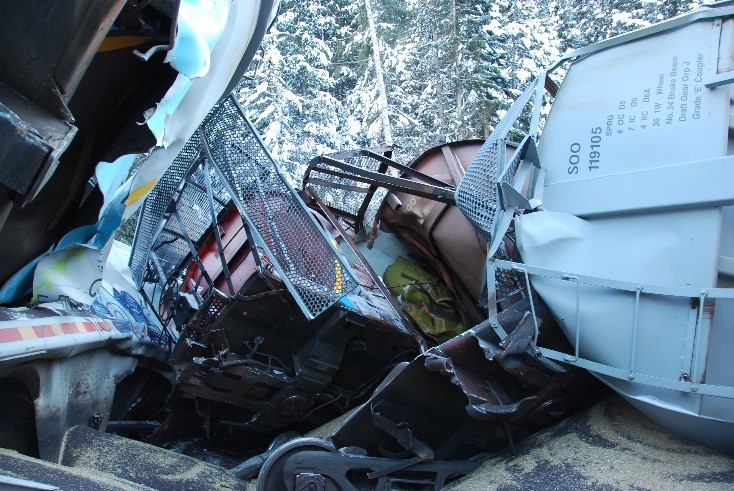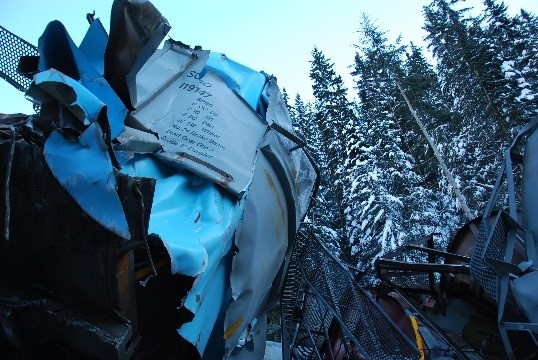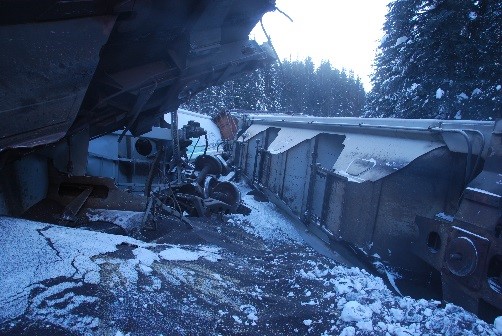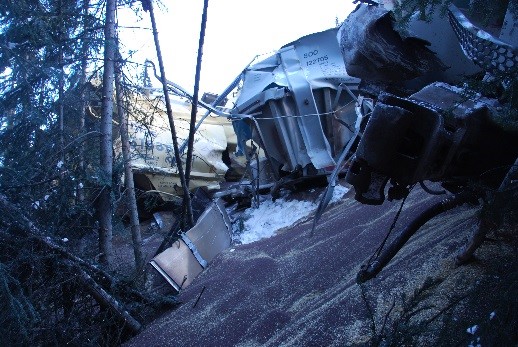Uncontrolled movement of rolling stock and main-track train derailment
Canadian Pacific Railway Company
Freight train 301-349
Mile 130.6, Laggan Subdivision
Yoho, British Columbia
Executive summary
On 04 February 2019, the Canadian Pacific Railway Company (CP) freight train 301-349 being operated by a relief crew derailed on Field Hill near Field, British Columbia, on a 13.5-mile section of track with a steep descending grade (average 2.2%) and several sharp curves. The 3 crew members—a locomotive engineer, a conductor, and a conductor trainee—were fatally injured in the derailment.
The accident
Before the emergency stop
The unit grain train,Footnote 1 hauling 112 loaded hopper cars, weighing 15 042 tons, and measuring 6676 feet long, had left Calgary, Alberta, at about 1430Footnote 2 the previous day, operated by an inbound crewFootnote 3 consisting of a locomotive engineer and a conductor. It travelled west on the Laggan Subdivision, which runs from Calgary to Field. As the train progressed into the mountains, it encountered extreme cold temperatures (below −25 °C).
The train started its descent of Field Hill at approximately 2136. When the entire train was on the steepest part of the grade, it was not able to hold its speed at or below the maximum 15-mph limit. When the speed reached 21 mph, the inbound crew applied the brakes in emergency, as required by railway operating procedures. At approximately 2149, the train came to a stop at Partridge, British Columbia (Mile 127.46). From there, about 9 miles of descending 2.2% grade remained ahead of the train.
While stopped in emergency
After the inbound crew brought the train to an emergency stop, they had a job briefing with the trainmaster. It was decided to get the train underway again by releasing the emergency brake application and allowing the train’s air brakes to recharge as the train continued its descent (an operation called release and catch). In order to limit the train’s acceleration after the brakes were released, the pressure retaining valvesFootnote 4 had to be set to the high-pressure position on 84 of the rail cars. The conductor completed this task at approximately 2330.
Since the inbound crew was nearing the end of their shift, a relief crew was called in to complete the trip to Field. The relief crew started their shift at 2230 and reached the train—after a series of circumstances had delayed their arrival—at about 0020 on 04 February 2019, some 2.5 hours after the train had been stopped in emergency. Meanwhile, the ambient temperature had dropped to −28 °C, and the train’s air brake system had been leaking compressed air, reducing the brakes’ capacity to hold the train on the steep grade.
The uncontrolled movement
The relief crew took over care and control of the train and prepared to resume the trip, but waited in the locomotive cab for the track unit carrying the departing inbound crew to be clear of the main track before they began the release and catch.
At 0042, before the relief crew were able to start that process, the train began to creep forward, gradually accelerating uncontrolled down the steep grade. The train was able to proceed over back-to-back reverse curves as its speed reached 53 mph, but it was not able to negotiate the sharp 9.8° curve immediately before the Kicking Horse River bridge. Two locomotives and 99 cars derailed, beginning at Mile 130.6.
Safety deficiencies contributing to the accident
The investigation identified a number of safety deficiencies that contributed to the accident:
- The degradation of air brake systems in extreme cold temperatures
- The limitations of current train brake test methodologies to accurately evaluate air brake performance in these temperatures
- Training that was not specific to the unique operating conditions of the Laggan Subdivision, and the inadequacy of experience of employees supervising mountain-gradeFootnote 5 operations on this subdivision
- The need for better identification of hazards through reporting, data trend analysis, and risk assessments under CP’s safety management system to support risk mitigation measures
- The need for additional physical defences to prevent uncontrolled movement of rolling stock
Air brake system degradation in extreme cold temperatures
The leakage of compressed air from the train’s air brake system degraded the performance of the brakes in the extreme cold temperature. As a result, even though the inbound locomotive engineer had increased the amount of braking several times while going down Field Hill towards Partridge, the train’s speed continued to increase. When the speed reached 21 mph, the train crew applied the brakes in emergency.
After the train stopped, the air brakes continued to leak over the next 3 hours until they could no longer hold the train.
The investigation used several different methods to determine the effectiveness of the brakes at the time of the occurrence, most notably extensive testing of 13 cars recovered from the accident site; review of wheel temperature data for the cars on the train; brake retarding force calculations; and computerized train dynamics simulations.
The results all indicated that on the descent of Field Hill before the emergency stop the brake effectiveness of the train was in the 60% to 62% range. After the train had been stationary on Field Hill for approximately 3 hours, the brake effort had degraded to less than 40% of the theoretical maximum braking effort.
Several factors contributed to the degradation of the occurrence train’s braking performance, especially the leakage of compressed air from the air brake cylinders on the rail cars, which was aggravated by the extreme cold temperatures. If leakage is excessive, or interferes with the normal operation of air brake equipment, the brakes may not apply at all, may produce less than the expected amount of retarding force, or may release after a period of time.
Limitations of current train brake test methodologies
Most air brake issues can be detected when freight cars and locomotives are tested and inspected. The single car test is particularly relevant in this case: it verifies the intended operation of car brakes and ensures, among other things, that the brakes remain applied and do not exceed allowable leakage rates. Cars in service are required to undergo this test at least once every 5 years. The cars on the occurrence train met this requirement.
Because this test is usually conducted in the warmer environment of a maintenance shop, it is very difficult to diagnose issues that reveal themselves only in extreme cold temperatures. Also, it cannot be used to evaluate the operation of the brakes on an entire train.
One of the brake tests that an entire train undergoes is the No. 1 brake test, which is conducted by certified car inspectors when a train is assembled prior to departure. It verifies the brake pipe integrity and continuity, brake rigging condition, air brake application and release, and piston travel on each car in the train. The train cannot depart unless at least 95% of the train brakes are operative. The occurrence train passed a No. 1 brake test at Alyth Yard before departing Calgary at ambient temperatures of about −26 °C.
By confirming that brakes apply and release, the No. 1 brake test can verify the responsiveness of an air brake system, but it cannot determine its effectiveness. In addition, because this test is done on a stationary train, it does not necessarily expose brake system defects that may materialize only while the train is in motion.
Until train brake test methodologies accurately evaluate air brake effectiveness, trains operating in extreme cold temperatures may continue to have ineffective braking, increasing the risk of loss of control and derailment.
Sufficiency of training
The route through the Rocky Mountains on the Laggan Subdivision traverses some of the most challenging railway operating terrain in North America. Winter temperatures, ice, and snow compound these challenges—and present specific ones as well.
Locomotive engineers
Locomotive engineers have to be certified for the subdivision on which they operate trains. On the Laggan Subdivision, the certification requires about 3 extra months of training on Field Hill operations. This training includes trips to practise and achieve a qualification in descending the mountain grade and safely resuming operation of a train that is stopped on the grade.
At the time of the occurrence, CP’s Field Hill certification program did not have a module on the particular challenges of operating a train on mountain grade in extreme cold conditions. This kind of training could make locomotive engineers more aware of the issues associated with air brake system operations in extreme cold and increase their vigilance when they encounter situations similar to those that arose in this occurrence.
Conductors
At the time of the occurrence, CP required conductors to do a classroom review of relevant operating procedures using job aids and track schematics in order to work on Field Hill. New hires also attended a 2-week classroom exercise in a simulated environment, where they operated as conductors applying all rules and operating instructions. However, there were no simulated trips specifically for Field Hill, and conductors were not required to be Field Hill–certified. If the classroom training does not address the unique needs of the territory where the employees will be working, and if the employees do not obtain the relevant on-the-job training on that territory, they will not be adequately prepared to perform their duties safely.
Trainmasters
After the emergency stop on Field Hill, CP operating instructions and procedures required the inbound crew to hold a job briefing with the trainmaster to determine the best course of action and follow the trainmaster’s instructions.
Trainmasters overseeing train operations must have the technical expertise, knowledge, and experience to discuss options and provide solutions in complex operational situations, such as emergency brake recovery on a mountain grade.
In this occurrence, the trainmaster had qualified as a locomotive engineer through the management training program, but he had not qualified on the Laggan Subdivision and so had never received the Field Hill training. The trainmaster’s effectiveness as a technical leader was likely weakened by the mismatch between his experience and the requirements of supervising mountain-grade operations on the Laggan Subdivision.
Many railway companies in North America employ road foremen. This is also a supervisory role, but it focuses on the technical aspects of train operations (train handling, air brake operation, train dynamics, etc.). Road foremen are experienced locomotive engineers with considerable technical and operational expertise specific to the territory that they oversee. At the time of the occurrence, there was one road foreman at the Calgary terminal (the position had been vacant from 2016 to 2018), but his technical expertise and experience were similar to a trainmaster’s.
Need for better hazard identification, data analysis, and risk assessment
A safety management system (SMS) is an internationally recognized framework that allows companies to manage risk effectively and make operations safer. Risk assessments are a cornerstone of a fully functioning and effective SMS and are essential for a company to operate safely.
The Railway Safety Management System Regulations, 2015 require railway companies to conduct risk assessments, including when a safety concern is identified. To identify safety concerns, railway companies are required to continually analyze their operations, current or emerging trends, and any recurring situations. The analyses use information such as employees’ reports of safety hazards and data from safety monitoring technologies.
Safety hazard reports
Safety hazard reports involving poorly braking unit grain trains descending Field Hill in cold winter temperatures had been submitted by train crews in January and February for a number of years. As individual notifications of this hazard were closed, new, similar reports continued to be recorded through the reporting system. Although CP’s procedure for safety hazard reporting was actively followed at the Calgary terminal, the trend analysis it required was not being done. Consequently, year after year, the reports on the poor braking of unit grain trains on Field Hill were closed, no formal risk assessment was conducted, and insufficient corrective action was taken.
Data from wheel temperature detectors
CP collects data from the wheel temperature detectors on its network. The work done by CP to use detectors to identify cars with brake system issues was novel in the industry when it began in 2008. These detectors make it possible to identify cars with cold wheels—cold wheels being an indicator of poor braking performance. The data collected in winter allow the railway to monitor the temperature sensitivity and performance of car air brakes when they are most susceptible to leakage.
Wheel temperature detectors are a safety monitoring technology and, as such, data from them must be analyzed to identify safety concerns, trends or emerging trends, or recurring situations. However, at the time of the occurrence, CP did not analyze the data available for grain cars, and an opportunity was missed to identify the hazard and mitigate any risks related to the braking performance of grain trains in extreme cold temperatures.
Risk assessments before operational changes
Risk assessments must be conducted prior to implementing operational changes which have the potential to introduce new hazards or increase the level of severity of existing hazards. In the years preceding the occurrence, CP made incremental changes to the operating procedures for Field Hill, which included the speed threshold at which trains are permitted to descend Field Hill and the requirements for retainers and hand brakes after an emergency brake application. CP did not, however, do any risk analysis to assess how these changes would affect safety.
The need for additional physical defences against uncontrolled movements
This occurrence is one of 589 occurrences reported to the TSB from 2010 to 2019 that were related to unplanned and uncontrolled movements among all railways in Canada. Loss of control, as in this occurrence, was the causal category in 22 (4%) of them. While uncontrolled movements due to loss of control are low-frequency events, 59% of them (13 out of 22) affected the main track.
Uncontrolled movements pose a significant risk to railway employees. When such movements involve the main track, the public—including passengers and people in the vicinity of the railway tracks—can also be exposed to risk. The risks increase significantly when a train carries dangerous goods. Consequently, these are considered low-frequency, high-risk events.
The TSB remains concerned that the current defences are not sufficient to reduce the number of uncontrolled movements and improve safety. Unplanned/uncontrolled movements of railway equipment is on the TSB’s Watchlist 2020, which is a list of the key safety issues that need to be addressed to make Canada’s transportation system even safer.
New technologies are available
Many technological advancements are available to North American railways to enhance train brake performance, including automatic parking brakes, high-capacity fade-resistant brake shoes, control valves with a brake cylinder maintaining feature, and retention of dynamic brake force on remote locomotives. These technological enhancements are examples of physical defences that are likely to reduce the frequency of unplanned and uncontrolled movements of railway rolling stock. The major freight railways have been receptive to assessing these advancements, but have not fully implemented them. At the time of the occurrence, there were no regulatory requirements for their implementation.
Safety action following the accident
Transportation Safety Board of Canada
Soon after the accident, the TSB communicated critical safety informationFootnote 6 on
- the prevention of uncontrolled train movements for trains stopped in emergency on grades of less than 1.8% (TSB Rail Safety Advisory Letter 04/19, issued on 11 April 2019);
- air brake system inspection and maintenance on grain hopper cars used in CP unit train operation (TSB Rail Safety Advisory Letter 05/19, issued on 11 April 2019); and
- the effectiveness of the No. 1 brake test (TSB Rail Safety Advisory Letter 04/20, issued on 17 April 2020).
Transport Canada
For its part, Transport Canada introduced numerous initiatives, including a Ministerial Order requiring that trains stopped by an emergency brake application on a grade of 1.8% or greater immediately apply a sufficient number of hand brakes before recharging the air brake system. The Ministerial Order was later repealed when it was superseded by Rule 66 of the Canadian Rail Operating Rules.
Transport Canada also approved the use of automated train brake effectiveness technology in lieu of No. 1 brake tests on CP’s unit grain trains operating between points in Western Canada and the Port of Vancouver.
Canadian Pacific
For its part, CP
- revised the train handling procedures for the Laggan Subdivision with respect to the use of retainers and hand brakes before recovering from an emergency brake application on mountain grades;
- issued Operating Bulletin OPER-AB-015-19, which introduced both new cold-weather speed restrictions for Field Hill for trains with a weight per operative brake of 100 tons or greater and a requirement that undesired releases of brakes on Field Hill be reported immediately to the rail traffic controller;
- monitored wheel temperatures on all westbound grain trains passing by detectors installed on the Laggan and the Mountain subdivisions, which resulted in more than 5000 grain cars being removed from service for repair;
- developed an advanced training program for locomotive engineers to build their skills and readiness for dealing with adverse conditions in the field. Adverse conditions covered by the training program included response to minor and major changes in air flow and brake pipe fluctuation, response to an undesired release of the air brakes, and procedures for emergency air brake recovery.
TSB recommendations
To address the systemic safety issues that posed a significant risk in this occurrence, the Board made 3 recommendations, namely
- that the Department of Transport establish enhanced test standards and requirements for time-based maintenance of brake cylinders on freight cars operating on steep descending grades in cold ambient temperatures (TSB Recommendation R22-01);
- that the Department of Transport require Canadian freight railways to develop and implement a schedule for the installation of automatic parking brakes on freight cars, prioritizing the retrofit of cars used in bulk commodity unit trains in mountain grade territory (TSB Recommendation R22-02); and
- that the Department of Transport require Canadian Pacific Railway Company to demonstrate that its safety management system can effectively identify hazards arising from operations using all available information, including employee hazard reports and data trends; assess the associated risks; and implement mitigation measures and validate that they are effective (TSB Recommendation R22-03).
Media materials
Speeches and presentations
News releases
TSB makes three recommendations to enhance safety of cold-weather train operations through
mountainous territory following a fatal derailment in 2019
Read the news
release
Investigation update notice: Train derailment near Field, BC
Read the news
release
Investigation update notice: Train derailment near Field, BC
Read the news
release
Investigation update notice: Train derailment near Field, BC
Read the news
release
Media advisory
TSB will hold a news conference to release its investigation report on the fatal derailment near
Field, British Columbia in February 2019
Read the media advisory
TSB will provide a news briefing on its investigation into the train derailment that occurred
near Field, British Columbia
Read the media advisory
Backgrounder
Deployment notice
TSB deploys a team of investigators to the site of a train derailment near Field, British Columbia
Calgary, Alberta, 4 February 2019 – The Transportation Safety Board of Canada (TSB) is deploying a team of investigators to the site of a Canadian Pacific train derailment near Field, British Columbia. The TSB will gather information and assess the occurrence.
Statements
TSB statement concerning CBC report related to TSB investigator comments about the Canadian
Pacific freight train accident near Field, BC, in February 2019
Read the statement
Investigation information
Download high-resolution photos from the TSB Flickr page.
Class of investigation
This is a class 2 investigation. These investigations are complex and involve several safety issues requiring in-depth analysis. Class 2 investigations, which frequently result in recommendations, are generally completed within 600 days. For more information, see the Policy on Occurrence Classification.
TSB investigation process
There are 3 phases to a TSB investigation
- Field phase: a team of investigators examines the occurrence site and wreckage, interviews witnesses and collects pertinent information.
- Examination and analysis phase: the TSB reviews pertinent records, tests components of the wreckage in the lab, determines the sequence of events and identifies safety deficiencies. When safety deficiencies are suspected or confirmed, the TSB advises the appropriate authority without waiting until publication of the final report.
- Report phase: a confidential draft report is approved by the Board and sent to persons and corporations who are directly concerned by the report. They then have the opportunity to dispute or correct information they believe to be incorrect. The Board considers all representations before approving the final report, which is subsequently released to the public.
For more information, see our Investigation process page.
The TSB is an independent agency that investigates air, marine, pipeline, and rail transportation occurrences. Its sole aim is the advancement of transportation safety. It is not the function of the Board to assign fault or determine civil or criminal liability.



